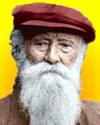
On 3 Apr 1837, John Burroughs was born, an American naturalist and author whose many writings and books, celebrated nature in highly readable essays. His work significantly nurtured the conservation movement in the United States. He absorbed up much of his knowledge of the nature and country life from growing up in the Catskill Mountains. This experience became valuable to drew upon in later life, when he started writing his essays. As a clerk in the Treasury Department in Washington, D.C., during the Civil War, he filled idle hours with writing about the outdoors he so loved. This became his first book, Wake-Robin. Returning to the Hudson River Valley in 1873, he began fruit farming and continued to write, publishing a new book about every two years. He traveled extensively, camping out with such friends as the naturalist John Muir and Theodore Roosevelt. Burroughs wrote in the style of Henry David Thoreau. An excerpt from Under the Apple-Trees (1916), that is a favorite of your Webmaster, is 'The Friendly Rocks.' It is a short essay. After you have enjoyed reading it, you may not look at a boulder-strewn field in the same way again. Here is a quick taste: “Time, geologic time, looks out at us from the rocks as from no other objects in the landscape.”

On 3 April 1896, Ralph A. Bagnold was born, the English geologist who was a leading authority on the mechanics of sediment transport and on eolian (wind-effect) processes. While a career soldier, serving in Egypt prior to WW II, he first studied sand dune formation and movement. Today's book pick is: The Physics of Blown Sand and Desert Dunes, by Ralph Bagnold. On this subject, he remains the authority, and he writes in an accessible style.
It is available from Amazon, typically about Used from $29.14. (As of earlier time of writing - subject to change.)
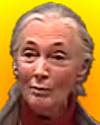 | Some humans are mathematicians—others aren’t. |
 | To treat your facts with imagination is one thing, to imagine your facts is quite another. |
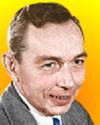 | Sometimes I wonder whether there is any such thing as biology. The word was invented rather late—in 1809—and other words like botany, zoology, physiology, anatomy, have much longer histories and in general cover more coherent and unified subject matters. … I would like to see the words removed from dictionaries and college catalogues. I think they do more harm than good because they separate things that should not be separated… |
| Before you look at today's web page, see if you can answer some of these questions about the events that happened on this day. Some of the names are very familiar. Others will likely stump you. Tickle your curiosity with these questions, then check your answers on today's web page. | |
| Births | |
 | Jane Goodall, born 3 Apr 1934, is a British ethologist, known for her exceptionally detailed and long-term research since 1960, the longest-running study of its kind in the natural habitat. What are the subjects of her study? |
 | Charles Wilkes, born 3 Apr 1798, was an American oceanographer, who led the first major ocean expedition (1838-42), which circled the globe, during which he identified and named a new continent. Which continent did he name? |
| Deaths | |
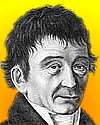 | Ernst Florens Friedrich Chladni (1756-1827) was a German physicist, known as the "father of acoustics" for his mathematical investigations of sound waves. Chladni figures are certain complex patterns of vibration displaying stationary nodal lines. How are Chladni figures displayed? |
| Events | |
 | On 3 Apr of a certain year, the first portable phone call was placed by inventor Martin Cooper. The phone weighed 30-oz, yet replaced replaced a car phone of the time that weighed more than 30 pounds. In which decade was the first portable phone call made? |
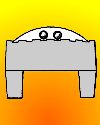 | On 3 Apr of a certain year, a British patent application for the first catseye road marker was recorded for inventor Percy Shaw (1889-1975). Shaw started Reflecting Roadstuds Ltd. to manufacture these familiar reflectors which mark the lane lines that are lit up at night by the lights of passing vehicles. In which decade did Shaw record his first catseye patent? |
Fast answers for the previous newsletter for April 2: Field’s Medal • Hermann Rorschach • the decade including the year 1838 • Francis Crick and James Watson • Aluminum.
 If you enjoy this newsletter, the website, or wish to offer encouragement or ideas, please send feedback by using your mail reader Reply button.
If you enjoy this newsletter, the website, or wish to offer encouragement or ideas, please send feedback by using your mail reader Reply button. Your click on a Facebook, StumbleUpon, or other social button on the site webpages is also a welcome sign of appreciation. Thank you for using them.
© This newsletter is copyright 2020 by todayinsci.com. Please respect the Webmaster's wishes and do not put copies online of the Newsletter — or any Today in Science History webpage. (If you already have done so, please remove them. Thank you.) Offline use in education is encouraged such as a printout on a bulletin board, or projected for classroom viewing. Online, descriptive links to our pages are welcomed, as these will provide a reader with the most recent revisions, additions and/or corrections of a webpage. For any other copyright questions, please contact the Webmaster by using your mail reader Reply button.
--
If you do not want to receive any more newsletters, Unsubscribe
To update your preferences and to unsubscribe visit this link
Executive Real Estate Business Class
-
"It was like a man with wings. It wasn't like anything you'd see on TV or in a monster movie." ...
About the publisher
Search This Blog
Blog Archive
-
▼
2021
(585)
-
▼
April
(57)
- On This Day for April 30 - George Washington inaug...
- Newsletter for Friday 30 April.
- On This Day for April 29 - British royal wedding, ...
- Newsletter for Thursday 29 April.
- On This Day for April 28 - Benito Mussolini execut...
- Newsletter for Wednesday 28 April.
- On This Day for April 27 - Independence for Sierra...
- Newsletter for Tuesday 27 April.
- On This Day for April 26 - Chernobyl nuclear accid...
- Newsletter for Monday 26 April.
- On This Day for April 25 - Hubble Space Telescope ...
- See How They Tracked Down Bin Laden
- Newsletter for Sunday 25 April.
- On This Day for April 24 - Installation of Pope Be...
- Newsletter for Saturday 24 April.
- On This Day for April 23 - Voting for Eritrea's in...
- Earth Day Bonus: Become a Climate Action Expert
- On This Day for April 22 - First Earth Day, Miguel...
- On This Day for April 21 - French elections held, ...
- Newsletter for Wednesday 21 April.
- On This Day for April 20 - Explosion on the Deepwa...
- Newsletter for Tuesday 20 April.
- On This Day for April 19 - American Revolution beg...
- Newsletter for Monday 19 April.
- On This Day for April 18 - The midnight ride of Pa...
- Newsletter for Sunday 18 April.
- On This Day for April 17 - Canada Act proclaimed, ...
- Newsletter for Saturday 17 April.
- On This Day for April 16 - Harriet Quimby's flight...
- Newsletter for Friday 16 April.
- On This Day for April 15 - Sinking of the Titanic,...
- Newsletter for Thursday 15 April.
- On This Day for April 14 - Abraham Lincoln shot, J...
- On This Day for April 13 - Alfred Dreyfus imprison...
- Newsletter for Tuesday 13 April.
- On This Day for April 12 - Launch of first space s...
- Newsletter for Monday 12 April.
- John of Gaunt: father of England’s medieval monarchy
- On This Day for April 11 - Napoleon's abdication a...
- Newsletter for Sunday 11 April.
- On This Day for April 10 - Anschluss approved in A...
- On This Day for April 9 - Fall of Baghdad, Jørn Ut...
- Newsletter for Friday 9 April.
- On This Day for April 8 - Celebration of the Buddh...
- On This Day for April 7 - Jack Nicklaus's first Ma...
- Newsletter for Wednesday 7 April.
- On This Day for April 6 - Olympics revived, Raphae...
- On This Day for April 5 - Battle of Maipú, Colin P...
- The history and origins of Easter
- On This Day for April 4 - Martin Luther King, Jr.,...
- Newsletter for Sunday 4 April.
- On This Day for April 3 - Implementation of the Ma...
- Newsletter for Saturday 3 April.
- On This Day for April 2 - Death of Pope John Paul ...
- Newsletter for Friday 2 April.
- On This Day for April 1 - Creation of Nunavut, Ser...
- Newsletter for Thursday 1 April.
-
▼
April
(57)
-
Blogroll
-
About
HistoryFact










0 comments:
Post a Comment